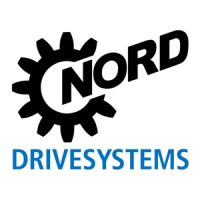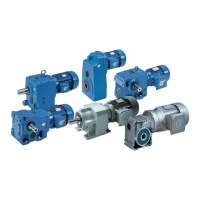www.nord.com B1091-GB-3212 -9-
5. Motors with protection type
Increased Safety Exe
Each machine must be protected against impermissible development of heat by a current-dependent
delayed protective switch tested for operation by an appointed body, with phase-failure protection in
compliance with VDE 0660 or an equivalent system in all phases. The protective system must be set to the
rated current. If windings are connected in a delta circuit the trips must be connected in series with the
winding phases and set to 0.58 times the rated current. If such a configuration is not possible, additional
precautions will be necessary (e.g. thermal machine protection).
If the rotor jams, the protective system must shut down within the t
E
-time specified for the respective
temperature class.
Electric machines for heavy starting (ramp time > 1.7 x t
E
-time) must be protected by a start-up monitoring
system in accordance with the provisions of the EC type test certificate.
Thermal machine protection by means of direct thermal monitoring of the winding with PTC thermistor
temperature sensor is permissible if it is certified and stated on the name plate.
Do not connect any voltage higher than 30V to the PTC thermistor temperature sensor!
If the only protection is a PTC thermistor temperature sensor, a performance-tested, certified PTC tripping
unit from an appointed body must be used. The PTC tripping unit must be provided with the following marks
concerning the degree of protection:
II (2) G
In Germany reference is made to DIN 57165/VDE 0165 and ElexV for setting up electrical installations
in explosive areas! In other countries the appropriate national regulations must be observed!
Operation in conjunction with an inverter must be explicitly certified. It is absolutely essential that the
separate manufacturer's instructions be observed. For Exe protection the motor, inverter and protective
systems must be identified as belonging together and the permissible operating data must be defined on the
joint EC type test certificate. The levels of voltage peaks generated by the inverter may be subjected to
unfavourable influences by the connecting cable installed between the inverter and the electric machine. In
the system comprising inverter-cable-electric machine the maximum figure for voltage peaks at the
connecting terminals on the machine must not be less than the figure specified in the separate
manufacturer's instructions. In addition, the EMC Directive must also be observed.
Any repairs must be performed by NORD or accepted by an officially recognised independent expert. The
work must be identified by means of an additional repair plate. With the exception of standardised,
commercial and equivalent parts, the only spare parts which may be used are genuine spare parts (see
spare parts list): this particularly applies to seals and connecting parts.
In the case of motors with closed condensation holes the threads of the plugs must be recoated with
Loctite 242 or Loxeal 82-21 after condensation has been drained off. As soon as that has been done the
plugs must be reinserted. Checking of electrical connections must be performed at regular intervals.
The connection terminals, protective earth terminal and equipotential bonding terminal must be inspected to
make sure they are firm. When doing so, check to make sure that the cable entry, cable gland and terminal
box gaskets are in good condition.
All work on electric machines must be performed with the machine vertical and with all terminals
disconnected from the mains.
If installation resistance is being measured the motor must be removed. Measurement must not be
performed in the explosive area. As soon as measurement has been completed discharge the connecting
terminals again by shorting them in order to prevent any spark discharges occurring in the explosive area.

